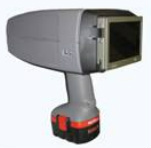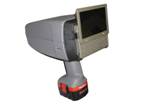XRF Technology
How does Energy Dispersive X-Ray Fluorescence (EDXRF) work?
Each of the atomic elements present in a sample produces a unique set of characteristic x-rays that is a fingerprint for that specific element. EDXRF analyzers determine the chemistry of a sample by measuring the spectrum of the characteristic x-rays emitted by the different elements in the sample when it is illuminated by high energy photons (x-rays). A fluorescent x-ray is created when a photon of sufficient energy strikes an atom in the sample, dislodging an electron from one of the atom’s inner orbital shells (lower quantum energy states). The atom regains stability, filling the vacancy left in the inner orbital drops to the lower energy state by releasing a fluorescent x-ray, and the energy of this fluorescent x-ray (typically measured in electron volts, eV) is equal to the specific difference in energy between two quantum states of the dropping electron.
Because the quantum states of each electron shell in each different type of atom (each of the atomic elements) is different, the energies of the fluorescent x-rays produced by different elements are also different: When a sample is measured via XRF, each element present in the sample emits its own unique fluorescent x-ray energy spectrum. By including and measuring a wide spectrum of the range of different characteristic fluorescent x-rays emitted by the different elements in the sample, the FINDER 100 Portable XRF Analyzer can rapidly determine the elements present in the sample and their relative concentrations, in other words, the elemental chemistry of the sample. For samples with known ranges of chemical composition, such as common grades of metal alloys, the FINDER 100 analyzer can also identify many sample types by name, typically in seconds.
Each of the atomic elements present in a sample produces a unique set of characteristic x-rays that is a fingerprint for that specific element. EDXRF analyzers determine the chemistry of a sample by measuring the spectrum of the characteristic x-rays emitted by the different elements in the sample when it is illuminated by high energy photons (x-rays). A fluorescent x-ray is created when a photon of sufficient energy strikes an atom in the sample, dislodging an electron from one of the atom’s inner orbital shells (lower quantum energy states). The atom regains stability, filling the vacancy left in the inner orbital drops to the lower energy state by releasing a fluorescent x-ray, and the energy of this fluorescent x-ray (typically measured in electron volts, eV) is equal to the specific difference in energy between two quantum states of the dropping electron.
Because the quantum states of each electron shell in each different type of atom (each of the atomic elements) is different, the energies of the fluorescent x-rays produced by different elements are also different: When a sample is measured via XRF, each element present in the sample emits its own unique fluorescent x-ray energy spectrum. By including and measuring a wide spectrum of the range of different characteristic fluorescent x-rays emitted by the different elements in the sample, the FINDER 100 Portable XRF Analyzer can rapidly determine the elements present in the sample and their relative concentrations, in other words, the elemental chemistry of the sample. For samples with known ranges of chemical composition, such as common grades of metal alloys, the FINDER 100 analyzer can also identify many sample types by name, typically in seconds.
FINDER 100

FINDER 100 is the leader in portable XRF for optical coating thickness and composition measurement, for a rational use on site and in-house.
FINDER 100 Portable XRF Analyzer is able to quickly, non-destructively, determine the heavy elemental composition of:
FINDER 100 Portable XRF Analyzer is able to quickly, non-destructively, determine the heavy elemental composition of:
- Metal and precious metal samples
- Rocks and soil
- Slurries and liquid samples
- Painted surfaces, including wood, concrete, plaster, drywall and other building materials
- Dust collected on wipe samples
- Airborne heavy elements collected on filters
| Walopt Finder 100 Tech Specs |
EASY TO USE

Portable and lightweight. It is used as "point and shoot". The detector is controlled by an integrated micro-PC, running Windows® and specialized software. Wireless solutions allows remote control and data handling together with an automatic edition and printing of report.
A set of light rechargeable batteries together with an AC adapter allows
continuous operation.
A set of light rechargeable batteries together with an AC adapter allows
continuous operation.
RELIABLE

Image courtesy of ESA
Accurate measurement in a large range of thickness, even for Light elements. Heavy elements detections is realized with an unprecedented accuracy thanks to the software Particularly, the software avoids false negative detection, where others fail.
SAFE

X-ray emission is controlled by a dedicated safety system. According to regulations of most countries, the use of the FINDER100 is friendly and avoids going through the red tape as for the radioactive sources.
CHEAP

The FINDER100 is presently the LEADER in terms of performance and price. It is the result of a long and high level Technological Research.
